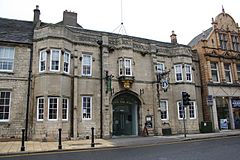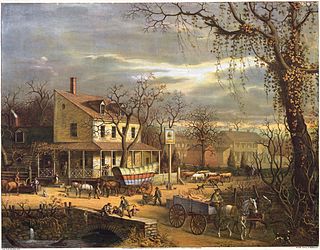
Inns are generally establishments or buildings where travelers can seek lodging, and usually, food and drink. Inns are typically located in the country or along a highway; before the advent of motorized transportation they also provided accommodation for horses.

Richard III was King of England and Lord of Ireland from 26 June 1483 until his death in 1485. He was the last king of the House of York and the last of the Plantagenet dynasty. His defeat and death at the Battle of Bosworth Field, the last decisive battle of the Wars of the Roses, marked the end of the Middle Ages in England. He is the protagonist of Richard III, one of William Shakespeare's history plays.
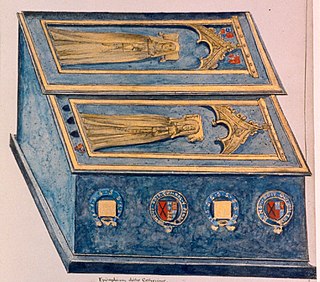
Katherine Swynford, Duchess of Lancaster, also spelled Katharine or Catherine, was the third wife of John of Gaunt, Duke of Lancaster, a son of King Edward III. She had been the Duke's lover for many years before their marriage. The couple's children, born before the marriage, were later legitimised during the reign of the Duke's nephew, Richard II. When the Duke's son from his first marriage overthrew Richard, becoming Henry IV, he introduced a provision that neither they nor their descendants could ever claim the throne of England; however, the legitimacy for all rights was a parliamentary statute that Henry IV lacked the authority to amend.
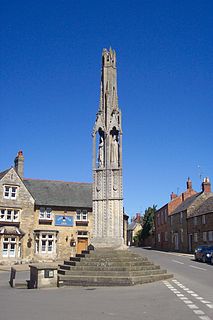
The Eleanor crosses were a series of twelve tall and lavishly decorated stone monuments topped with crosses erected in a line down part of the east of England. King Edward I had them built between 1291 and about 1295 in memory of his beloved wife Eleanor of Castile. The King and Queen had been married for 36 years and she stayed by the King’s side through his many travels. While on a royal progress, she died in the East Midlands in November 1290. The crosses, erected in her memory, marked the nightly resting-places along the route taken when her body was transported to Westminster Abbey near London.

Grantham is a market and industrial town in the South Kesteven district of Lincolnshire, England. It straddles the London–Edinburgh East Coast Main Line and the River Witham and is bounded to the west by the A1 north–south trunk road. It lies some 23 miles south of the county town, Lincoln, and 22 miles east of Nottingham. The population in 2016 was put at 44,580. Grantham is known as the birthplace of the UK Prime Minister Margaret Thatcher, for educating Isaac Newton at the King's School, as the workplace of the UK's first female police officer, Edith Smith in 1914, and for making the UK's first running diesel engine in 1892 and tractor in 1896. Thomas Paine worked there as an excise officer in the 1790s.

The Angel, Islington, is a historic landmark and a series of buildings that have stood on the corner of Islington High Street and Pentonville Road in Islington, London, England. The land originally belonged to the Clerkenwell Priory and has had various properties built on it since the 16th century. An inn on the site was called the "Angel Inn" by 1614, and the crossing became generally known as "the Angel". The site was bisected by the New Road, which opened in 1756, and properties on the site have been rebuilt several times up to the 20th century. The corner site gave its name to Angel tube station, opened in 1901, and the surrounding Angel area of London.

Somerton Castle is located approximately 1 mile (1.6 km) west of the village of Boothby Graffoe in Lincolnshire, England and to the south of the city of Lincoln, England. The site is on low-lying land between the Lincoln Edge and the River Witham. Although Somerton Castle is in the parish of Boothby Graffoe, it is in the Manor of Waddington and this portion is often referred to as the Manor of Somerton Castle. Antony Bek probably built the castle in 1281 and he gave it to King Edward II in 1309. King John II of France was imprisoned at Somerton Castle between 1359 and 1360, having been taken prisoner after the Battle of Poitiers. It continued as crown property until it was sold by Charles I in 1628, since when the castle has continued in private ownership.
The pubs and inns in Grantham reflect to a great extent the history of the town, soke, and Parliamentary constituency of Grantham, Lincolnshire, England.
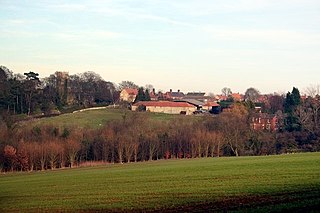
Navenby is a village and civil parish in Lincolnshire, England. Lying 8 miles (13 km) south from the county town of Lincoln and 9 miles (14 km) north-northwest from Sleaford, Navenby had a population of 2,128 at the time of the 2011 census and is a dormitory village for Lincoln. It forms part of the North Kesteven local government district and, in March 2011, it was named as the 'Best Value Village' in England following a national survey.

Acton Green is a residential neighbourhood in Chiswick and the London Borough of Ealing, in West London, England. It is named for the nearby Acton Green common. It was once home to many small laundries and was accordingly known as "Soapsuds Island".
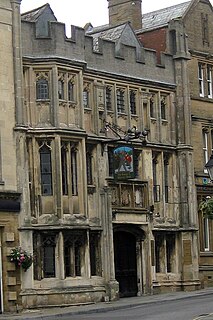
The George Hotel and Pilgrims' Inn in Glastonbury, Somerset, England, was built in the late 15th century to accommodate visitors to Glastonbury Abbey. It has been designated as a Grade I listed building. It is claimed to be the oldest purpose built public house in the South West of England.

The following is a list of reportedly haunted locations in the United Kingdom.
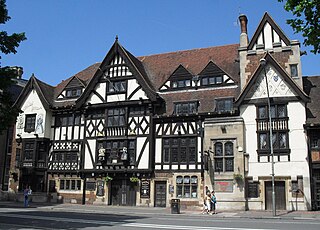
The King and Queen is a pub in the seaside resort of Brighton, part of the city of Brighton and Hove. The present building, a "striking" architectural "pantomime" by the prolific local firm Clayton & Black, dates from the 1930s, but a pub of this name has stood on the site since 1860—making it one of the first developments beyond the boundaries of the ancient village. This 18th-century pub was, in turn, converted from a former farmhouse. Built using materials characteristic of 16th-century Vernacular architecture, the pub is in the Mock Tudor style and has a wide range of extravagant decorative features inside and outside—contrasting with the simple design of the neighbouring offices at 20–22 Marlborough Place, designed a year later. English Heritage has listed the pub at Grade II for its architectural and historical importance.
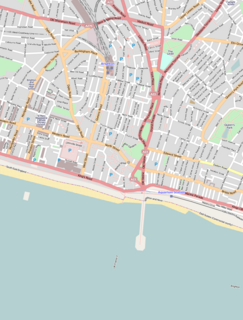
The Royal Pavilion Tavern, commonly known as the Pavilion Tavern or Pav Tav, was for nearly 200 years a pub in the centre of Brighton, part of the English coastal city of Brighton and Hove. Converted from a house into the Royal Pavilion Hotel in the early 19th century, its original role soon changed from a hotel to a pub, in which guise it remained until its closure in September 2019. The building was also used as a court for several years early in its history, and prominent local architect Amon Henry Wilds was responsible for its redesign as a hotel and inn. English Heritage has listed the building at Grade II for its architectural and historical importance, and it stands within a conservation area.

The Angel Inn is a public house in Andover, Hampshire. Constructed in the mid-15th century, it is one of England's oldest surviving inns, and the oldest and most complete example in Hampshire. It is a Grade II* listed building, of "more than special interest nationally." Despite alterations in the 16th, 17th, 18th and 19th centuries, the medieval timber frame, features and decorative details remain "remarkably intact." Archaeological and documentary evidence suggest that it was built on the site of a previous inn—the College Inn—which was destroyed in the Great Fire of Andover in 1434.
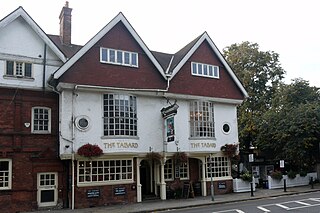
The block of three buildings containing The Tabard public house is a Grade II* listed structure in Chiswick, London. The block, with a row of seven gables in its roof, was designed by Norman Shaw in 1880 as part of the community focus of the Bedford Park garden suburb. The block contains the Bedford Park Stores, once a co-operative, and a house for the manager.
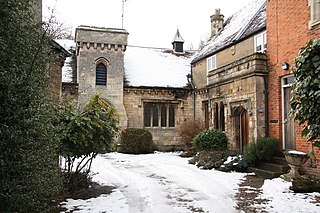
The Manor House is a set of connected buildings located on Northgate in the English town of Sleaford, Lincolnshire. A complex arrangement, parts of the Manor House date to the 16th century, but they were extended with the addition of the Georgian Rhodes House and later Gothic-Revival work. It was a private residence until the 20th century, and is now divided into commercial properties and residential apartments. The house was owned by a number of families and individuals, including local banker and businessman Benjamin Handley and Sophia Peacock, whose nephews, Cecil and Frank Rhodes, spent their summers at the estate as children.

The Old White Horse Cellar also known as Hatchetts White Horse Cellar at No. 155 Piccadilly, was one of the best known coaching inns in England during the 18th and 19th centuries. The first mention of the White Horse Cellar is in 1720. It was originally located on the corner of Arlington Street, where the Ritz Hotel is now located. The first landlord, a man named Williams, named it in honor of the newly established House of Hanover, whose heraldic emblem featured a white horse. The White Horse rose to prominence under Abraham Hatchett who later moved it to the opposite side of the road on the corner of Albemarle Street, where it was known as "Hatchett’s Hotel and White Horse Cellar". The precise date of the move is not known, but was precipitated by the construction of the Bath Hotel, which was located on the corner of Piccadilly and Arlington as early as 1798. It was torn down in 1884 to make room for the Albemarle.
Arthur Edward Sewell (1872–1946) was an English architect, particularly known for the public houses he designed whilst working as the in-house architect for Truman's Brewery. His career peaked in the 1920s and 1930s, and at least five pubs that he designed in that period are now listed buildings with Historic England. In all, he designed around 50 pubs.

The Bull and Mouth Inn was a coaching inn in the City of London that dated from before the Great Fire of London in 1666. It was located between Bull and Mouth Street in the north and Angel Street in the south. It was once an important arrival and departure point for coaches from all over Britain, but particularly for the north of England and Scotland. It became the Queen's Hotel in 1830 but was demolished in 1887 or 1888 when new post office buildings were built in St Martin's Le Grand.
